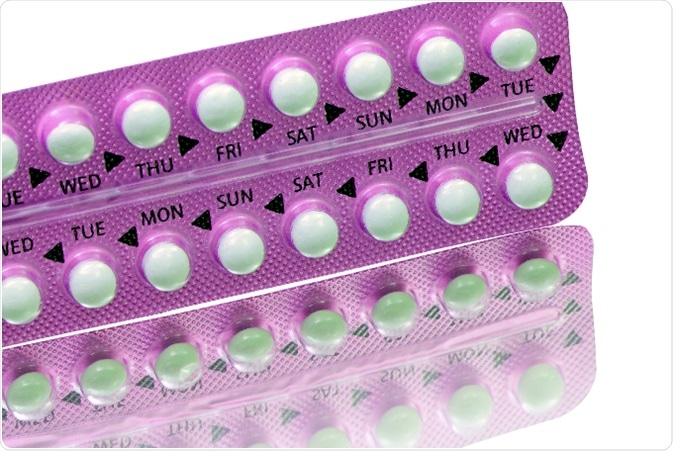The combined pill is the birth control pill containing artificial versions of estrogen and progestogen. These are hormones that the female body secretes naturally in the ovaries, and which are essential to the optimal functioning of the reproductive system. They regulate the menstrual cycle. thickening of the uterus lining and ovulation.

Credit: areeya_ann / Shutterstock.com
While the primary purpose of the combined pill was to prevent unintended pregnancies, it is also prescribed to treat premenstrual syndrome (PMS), regulate heavy menstruation, and ease painful periods. It does not provide any protection against sexually transmitted disease.
How does the combined pill work?
- The hormone-like chemicals in the pill prevent the ovaries from ovulation. As a result, no egg is released for the sperm to fertilize.
- The chemicals also help increase the thickness of the mucus of the cervix. The thicker mucus makes it tough for the sperm to swim through and reach the womb where the egg would be.
- The pill makes the blood lining the uterus thin. This resultant lack of nutritional blood will not allow a fertilized egg to implant itself in the womb, so it will be unable to grow into a fetus.
Side effects of being on the combined pill
The Combined Pill is 99% effective at preventing pregnancies and is, therefore, a popular method of birth control. However there are some side effects of being on the pill. Should you suffer incessantly from these side effects it may be advisable to consult the doctor and change the type of pill you are using. These side effects include:
- Mood swings
- Tenderness in the breasts
- Headaches
- Low risk of blood clots
- Risk of cervical cancer
- Changes in body weight due to fluid retention
Types of combined pills
The hormones and the dosage in which they are delivered to the system differ between types of combined pills. There are many different brand names available in the market but there are essentially three different forms of the pill. The three main types of combined pills are:
Monophasic 21 day pills
These contain the same quantity of hormone in all the pills. These are the most commonly used combined pills. The pack contains 21 pills and must be consumed every day. Following these 21 days, there is a seven day break before the next pack of pills should be taken.
Phasic 21 day pills
There may be two or three different coloured pills in different sections of a phasic pack. Each section of the pack of pills contains a different amount of each constituent hormone. They need to be taken in exactly the manner prescribed for them to be effective. As is the case with the monophasic pills, one pill should be taken each day for 21 days and no pills are taken for 7 days before the cycle starts again.
Every day pills
This pack has 21 active pills and 7 inactive ones. In this case, a pill is taken every day for the 28 day cycle. Unlike the other pills, the next pack for this should be started as soon as the first one finishes i.e. there is with no week-long gap between packs of pills. This is good for women who are likely to forget or miscalculate their 7 day break before restarting the next pack of combined pills. Of course the order of the pills must be meticulously followed in this pack so that the placebo pills do not interfere with the actual contraception action.
Who can use the pill?
It is necessary to consult a health care provider before starting to use the pill. It is a good contraception method for most women who are healthy, and who will not forget to take it regularly. However there are some conditions under which this may not be the most appropriate medication, some of which are detailed below.
- Women over 35 years of age who smoke, or who quit smoking less than a year ago.
- Women who are overweight, as the pill is less effective as a contraception method for them.
- If still breastfeeding a child.
- Those on certain medicines which will impede effectiveness of the pill.
- Those suffering from thrombosis currently, or in the past. Even if an immediate family member has suffered from thrombosis, the pill is ill advised.
- Anyone with heart disease, or who has suffered a cardiac arrest.
- If you have hypertension or any circulatory disease.
- Those suffering from breast cancer, present or past.
- Women who have diabetes and suffer from complications.
- Women who are immobile for long time or use wheelchairs.
- If you reside at an altitude of 4500m or more.
- Women who suffer regular migraine attacks.
Those who wish to use the combined pill as a contraception method should speak at length with a health care provider before settling on one. Provide full disclosure about existing and past medical conditions as well as family illnesses. If the pill causes a number of unacceptable side effects, you can get the prescription changed.
References:
- http://www.nhs.uk/conditions/contraception-guide/pages/combined-contraceptive-pill.aspx
- http://www.fpa.org.uk/contraception-help/combined-pill
Further Reading
- All Contraception Content
- Advantages and Disadvantages of the Contraceptive Patch
- Advantages and Disadvantages of the Contraceptive Implant
- Advantages and Disadvantages of the Contraceptive Vaginal Ring
- Do Contraceptive Injections Affect Bones?
Last Updated: Feb 26, 2019

Written by
Cashmere Lashkari
Cashmere graduated from Nowrosjee Wadia College, Pune with distinction in English Honours with Psychology. She went on to gain two post graduations in Public Relations and Human Resource Training and Development. She has worked as a content writer for nearly two decades. Occasionally she conducts workshops for students and adults on persona enhancement, stress management, and law of attraction.
Source: Read Full Article
